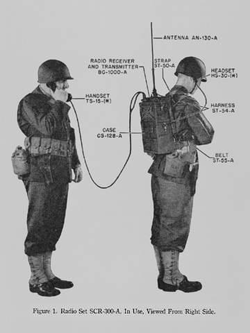SCR-300

The SCR-300 was a portable radio transceiver used by US Signal Corps in World War II. This backpack-mounted unit was the first two way radio to be nicknamed a "walkie talkie".[1]
History
In 1940, Motorola (then the Galvin Manufacturing Company) received a contract from the War Department to develop a portable, battery powered voice radio receiver/transmitter for field use by infantry units. The project engineering team consisted of Daniel E. Noble, who conceived of the design using frequency modulation, Henryk Magnuski who was the principal RF engineer, Marion Bond, Lloyd Morris, and Bill Vogel.
The final acceptance tests took place at Fort Knox, Kentucky. The performance of the SCR-300 during those tests demonstrated its capacity to communicate through interference and the rugged quality of the design. Motorola was to produce nearly 50,000 of the SCR-300 units during the course of the war.[2]
The British adopted the design of the SCR-300 for their own use from 1947 as the "Wireless Set No. 31".[3][4]
See also
- ARC-5
- AN/PRC-6
- BC-348
- BC-654
- R-390A
- SCR-299
- Signal Corps Radio
- Wireless Set No. 19
- Vintage amateur radio
- AN/PRC-77 Portable Transceiver
- SCR-694
References
- ↑ SCR300.org
- ↑ The Founder's Touch: The Life of Paul Galvin of Motorola by Harry Mark Petrakis, 1965, McGraw-Hill, NY, p. 144-147, "The Talkies - Handie and Walkie"
- ↑ Radio Set SCR-300-A, War Department Technical Manual TM 11-242
- ↑ SCR-300 Backpack Radio Olivedrab Radio
- TM 11-983 for PP-114 Vibrator power supply dated 1945
- TM 11-637 for AN/VRC-3 dated 1944